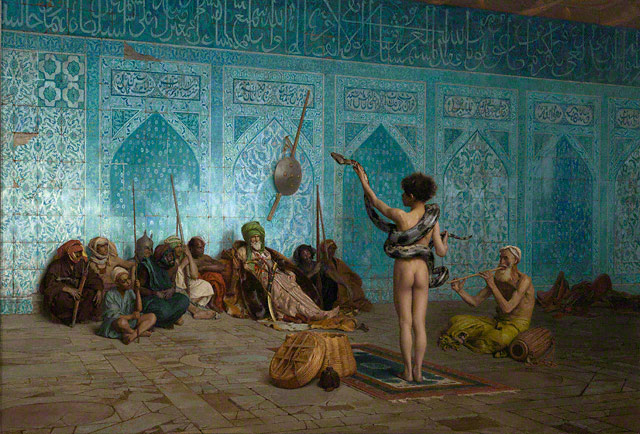During a tour of the new exhibition The Spectacular Art of Jean-Léon Gérôme, curator Mary Morton stopped in front of Gérôme’s Snake Charmer and asked the audience, “What do you see?”

The Snake Charmer, Jean-Léon Gérôme, about 1870, oil on canvas. Courtesy of and © Sterling and Francine Clark Art Institute, Williamstown, Massachusetts, U.S.A., 1955.51 (photo by Michael Agee)
Murmurs spread through the crowd. One brave little girl raised her hand and said, “There’s a boy, and he’s naked.” This statement might not sound controversial today. But it would have in the 19th century, when Gérôme first exhibited his grand Orientalist paintings at the Paris Salon. At the time, naked bodies in art were shocking—and completely different from nudes, which weren’t shocking at all.
In the western art historical tradition, a nude is a body studied for aesthetic purposes. Nudes distance us from the body as a sexual object; they are pure beautiful form. (Here’s a classic example by Pierre-Paul Prud’hon from the Getty’s collection.) A nude existed for art’s sake, while a naked body appealed to our lower appetites.
In the 1800s, “naked vs. nude” was a matter of hot debate—and not just academic debate, either. In 1851, for example, photographer Félix Jacques Moulin was sentenced to a month in prison for his racy photographs of naked (not nude) women.
When Gérôme displayed his polychrome sculptures, critics charged that the artist had debased the nude and sculpted naked women instead. His addition of color made the forms so realistic and lifelike that they could no longer be appreciated on an aesthetic level alone. It jarred 19th-century audiences to see naked figures with painted eyes and colored hair.

Corinth, Jean-Léon Gérôme, 1903–4, tinted marble, colored marble, gilt bronze, enamel, and semiprecious stones. J. Nicholson, Beverly Hills, California
Gérôme’s decision to create polychrome sculpture was influenced by discoveries in archeology—in particular, evidence of the ancient Greeks’ use of polychromy. Gérôme’s take on classicism, however, was dramatically different from that of his contemporaries and predecessors, such as Jean-Auguste-Dominique Ingres. Where Ingres was restrained, Gérôme was over the top. Where Ingres painted nudes, Gérôme flaunted naked bodies.
In Kenneth Clark’s classic definition, nakedness implies embarrassment at being deprived of clothes. But as the murmurs in the gallery showed, it is the viewers of Gérôme’s art—not his subjects—who feel that embarrassment.




…and now strip clubs use the word “nude”.
naked vs nude..well, it really depends on education when it comes to viewing images of people without clothes. It’s in the eyes of the beholder. Seems likely that “naked”… is more revealing and perhaps more blatant, but then again the image structure and contents also plays a part in the visual imprint.
If you took the SAME naked/nude body (through photoshop) and placed it into different scenes, it would possibly create a different reaction. Seems also likely that if a viewer is uncomfortable with their own body they may be more affected by nudity.
In self-portraiture nudes, people sometimes feel uncomfortable viewing nude self-portraits just by the very name. Self — seeing the self, viewing the self as nude — strikes a cord from deep within. People seem to identify the images as if….”I could or could not reveal myself that way”…They may like the image…but still feel a personal reaction to the nudity/nakedness.